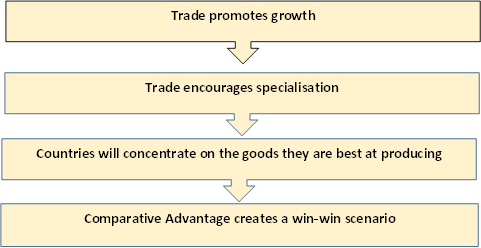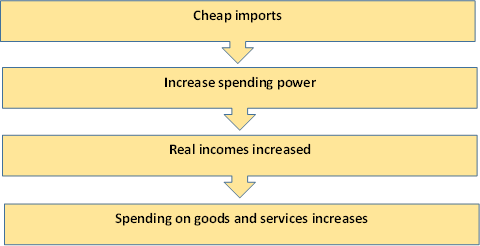Handout: Comparative Advantage
8th September 2015
Comparative Advantage
Summary
- If one country has lower costs of production for a good than another country, then it is said to have an absolute advantage in the production of that good.
- International trade will take place even if a country has no absolute advantage in the production of any good. So long as it has a comparative advantage in the production of one good, international trade will be advantageous.
- Transport costs will limit any welfare gain from international trade. However any economies of scale in production will increase the gains from trade.
- The terms of trade, (the ratio of export prices to import prices) will determine whether trade is advantageous for a country.
- David Ricardo thought that comparative advantage existed because of differences in labour costs between countries. In the Heckscher-Ohlin model comparative advantage is explained by differences in the price of products. However, much world trade is the result of non-price competition between countries. Design, reliability, availability and image are some of the factors which determine purchases of foreign goods.
- In the theory of preferences similarity, it is argued that trade takes place because consumer demand more choice than can be provided by domestic producers.
Absolute AdvantageAssume that there are only two commodities, wheat and wine. Labour is the only cost, measured in terms of man hours to produce one unit of output. It costs more in man hours to produce a unit of wine in England than in Portugal. Portugal is said to have an ABSOLUTE ADVANTAGE in the production of wine. It can produce both goods but is more efficient in the production of wine. On the other hand, it costs more in man hours to produce wheat in Portugal than in England. So, if England has an ABSOLUTE ADVANTAGE in the production of wheat. It will be mutually beneficial for England to specialise in the production of wheat and for Portugal to specialise in the production of wine. It’s a win – win scenario |
Comparative AdvantageDavid Ricardo realised that absolute advantage theory was a limited case of a more general theory. Countries which did not have a comparative advantage could still trade and gain from doing so. Example: It may be that Portugal can produce wine and wheat more cheaply than England. If a unit of wine costs the same amount to produce as 2 units of wheat. production of an extra unit of wine means foregoing production of two units of wheat (i.e. the opportunity cost of a unit of wines is two units of wheat. in Portugal a unit of wine costs 1 1/2 units of wheat to produce (the opportunity cost of a unit of wine is 1 1/2 units of wheat in Portugal). Portugal has an absolute advantage in producing both products. Portugal is relatively better at producing wine than wheat: so Portugal is said to have a COMPARATIVE ADVANTAGE in the production wine. England is relatively better at producing wheat than wine so is said to have a COMPARATIVE ADVANTAGE in the production of wheat. Industries that have a comparative advantage will grow when trade is possible. Trade will promote a continuing process of structural change as resources adjust to trade flows. |
The Benefits of Trade
Effect of Trade on Incomes



0 Comments